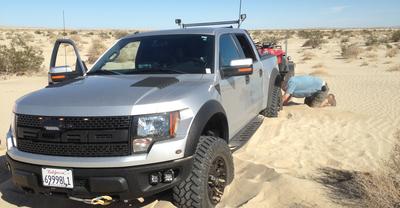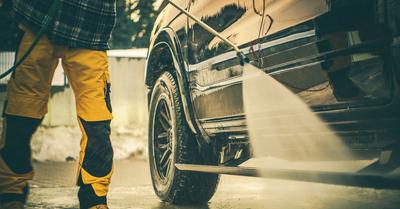Dealing with a flooded engine can be a frustrating experience, especially if you’re in a rush or can’t afford an expensive repair. Luckily, it’s a quick fix.
To fix a flooded engine, inspect the vehicle to identify the issue. It’s usually caused by excess fuel in the engine due to a disrupted air-to-fuel ratio. Open the hood, allow the fuel to evaporate, and inspect the spark plugs. Next, crank the engine, get the car started, and let the car warm up.
We have years of experience repairing engines and working closely with all types of vehicles. This guide will discuss the steps to fix a flooded engine and get your car back on the road in no time. So, let's dive into the process and address this issue head-on.
Key Takeaways
- To fix a flooded engine, open the hood of the vehicle to allow fuel to evaporate, inspect the spark plugs, crank the engine, get the vehicle started, and allow the engine to warm up.
- A bad fuel injector, faulty spark plugs, and not allowing the engine to warm up in the cold can cause the engine to flood.
- Diesel engine vehicles cannot flood.
This article may contain affiliate links where we earn a commission from qualifying purchases.
How To Fix A Flooded Engine: Quick & Simple Steps
We understand that dealing with a flooded engine can be frustrating, but don't worry. We got you covered. To fix a flooded engine, you typically need to clear out the excess fuel.
One way to do this on a fuel-injected car is to press the accelerator pedal to the floor (which signals the car's computer to stop sending fuel into the engine) and then try starting the engine. Here's a step-by-step guide on how to fix a flooded engine.
Identify The Issue
As mentioned, this is usually caused because of excess fuel. You’ll notice the issue after opening the hood and seeing extra fuel or catching a strong scent of gasoline.
Open the hood and let it sit open for at least 20 minutes. As long as the spark plugs are intact, the fuel should evaporate.
Inspect The Spark Plugs
In most vehicles, you'll find spark plugs along the side of the engine block. In V-shaped engine configurations, they'll be on both sides of the engine. They are connected to thick wires, usually called ignition or spark plug wires.
Grab the plug wire by the boot (the thicker end that connects to the spark plug), twist it a little to loosen it, then pull it off. Don't pull on the wire itself, as this could damage it.
Before you proceed, inspect the wire and boot for any signs of wear, damage, or burning. If you find any, you may need to replace your spark plug wires.
If the spark plug is in good condition, you can screw it back into the engine block (always start threading it in by hand to avoid cross-threading, then tighten it with a wrench). If it's not, you'll need to install a new one.
Crank The Engine
Cranking the engine is another term for starting the engine, which refers to engaging the starter motor to turn the engine's crankshaft, creating enough compression to start the engine.
For a car with a traditional key ignition, insert the key into the ignition switch. Do this for about ten seconds. You should hear the engine try to start. For a car with a push-button start, ensure the key fob is inside the vehicle, then press the start button.
Remember not to crank the engine for too long. If it doesn't start within 10 seconds, stop cranking and wait for a few seconds before attempting again to avoid overheating and damaging the starter motor.
Start The Engine
For a push-button start, simply press and release the button. You should hear the engine turning over, which means it's trying to start. Once the engine starts, release the key, and it should spring back to the "on" position.
Allow The Engine To Idle & Warm Up
Once the vehicle starts, allow it to run for a while in idle. The objective is to warm up the car to burn excess fuel.
What Causes An Engine To Flood?
A flooded car engine is an internal combustion engine that has been fed an excessive amount of fuel and not enough air. If your engine becomes flooded, there's too much fuel in the combustion chamber, which could prevent the spark plugs from igniting the fuel as they should.
This is typically a problem associated with gasoline engines. The root cause of engine flooding has to do with the air-fuel mixture inside the combustion chamber.
For an engine to run smoothly, it needs the right balance of fuel and air. In most gasoline engines, the ideal air-to-fuel ratio is 14.7:1. This means you need about 14.7 parts air to one part fuel.
If there's too much fuel and not enough air, the spark plugs may not be able to ignite all the fuel, leading to flooding. Here are some common causes for this to happen to a car engine.
Carburetor Issues
If the carburetor isn't adjusted properly, it could send too much fuel into the engine. A worn-out or stuck carburetor float could also cause flooding. This happens in a few different ways.
The float in the carburetor rises and falls with the level of fuel in the float bowl. When the fuel reaches a certain level, the float pushes the needle into the seat, blocking the fuel inlet and stopping fuel flow into the bowl.
A faulty choke can also happen. The choke restricts air intake to increase the fuel-air mixture when starting a cold engine. If the choke is stuck in the closed position or not opening properly after the engine starts, it will cause a rich condition, which can lead to flooding.
Bad Fuel Injector
Fuel injectors spray a mist of fuel into the engine. If they're leaking or spraying too much fuel, it could lead to a flooded engine. This commonly occurs because of a pressure regulator problem or electrical issues.
Although not a part of the fuel injector itself, the fuel pressure regulator plays a crucial role in the fuel injection system. It maintains a proper pressure level for the fuel sent to the injectors.
If it fails and allows too much pressure, the fuel injectors might deliver too much fuel, leading to a rich mixture and potential flooding. When there is an electrical issue, the injector might be kept open for too long, causing too much fuel to be sprayed into the intake manifold.
Overuse Without Allowing The Engine To Warm Up
Doing this may leave unburned fuel in the combustion chamber, which can lead to flooding, especially in colder weather. This is why most people wait for the engine to warm up in cold weather.
The engine sounds faulty in cold temperatures. Allowing it to sit and idle before driving is smart. You’ll know the engine is ready to drive when the engine note changes and the idle speed drops slightly.
Spark Plug & Ignition System Problems
If the spark plugs or ignition system aren't working properly, they won't be able to ignite the fuel in the combustion chamber, which could lead to flooding.
Over time, spark plugs can become worn out and may not produce a spark strong enough to ignite the air-fuel mixture. This could cause the fuel to accumulate in the combustion chamber, leading to a flooded engine.
The ignition coil transforms the car's low voltage to the thousands of volts needed to create an electric spark in the spark plugs, which ignites the fuel. If the ignition coil is not working properly, it may not provide enough voltage to the spark plugs, preventing them from igniting the fuel.
How To Identify & Diagnose a Flooded Engine
One of the first signs of a flooded engine is difficulty starting the car. If the engine cranks but doesn't start, it could be due to flooding.
Another symptom is the smell of gasoline coming from the engine or exhaust. Additionally, you might notice black smoke coming from the tailpipe when you finally get the engine running.
Lastly, listen for an unusual engine noise. Usually, this noise indicates the engine is flooded, and an improper air and fuel mixture causes the noise.
Understanding the potential causes of a flooded engine can help us pinpoint the issue and provide an effective solution. Whether it's a simple repair or addressing a more complex issue, being aware of these common causes is essential for maintaining your vehicle's performance.
How To Prevent Engine Flooding
Small, four-cylinder engines are more likely to flood. This is because the unburnt fuel sits in the engine, causing problems with the spark plugs. It can also cause the fuel to bore wash the cylinder's piston rings.
Regular maintenance is key to keeping our engine in top shape. Changing the spark plugs, air filter, and oil routinely helps ensure optimal performance. Additionally, inspect the engine regularly for any cracks or leaks and seal them up with epoxy or another type of sealant.
This is the number one way to prevent engine flooding. But we also need to allow the engine to warm up in the cold. So next time it’s cold, and you’re in a rush, remember this.
How To Start Your Vehicle if the Engine Floods
First, let's determine if the engine is actually flooded. You might notice a strong fuel smell, the engine won't start, or it cranks but doesn't start. If you experience these symptoms, your engine is likely flooded.
Now, let's move on to starting your flooded engine. Before attempting any of the following steps, please ensure the vehicle is in a well-ventilated area to avoid inhaling harmful fumes.
- Open the hood for 20-30 minutes before attempting to start the vehicle.
- Press the accelerator pedal firmly to the floor. This allows more air to enter the engine and helps clear the excess fuel.
- While holding the pedal down, turn the ignition key to start the engine. Don't be alarmed if it takes a few attempts, as this is normal for a flooded engine.
- Once the engine starts, we recommend letting it idle for a short period to ensure it's running smoothly. You might also notice some smoke initially, but this should clear up as the engine burns off the excess fuel.
If your engine still doesn't start after following these steps, there might be other underlying issues, such as a faulty fuel injector or ignition system. In this case, it's best to consult a professional mechanic to diagnose and address the problem.
Can You Flood a Diesel Engine?
Diesel engines cannot flood because they work differently than traditional gasoline and petrol engines. This is mostly because the amount of fuel injected into the engine per stroke is very low.
This means excessive fuel is unlikely and less of a concern for car owners. The accelerator also controls the amount of fuel provided to the engine, unlike the air-to-fuel ratio in a petrol engine.
The throttle gas pedal controls the fuel pump and fuel injector. So this makes it unlikely for more fuel than needed to disrupt the engine and cause flooding.









